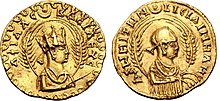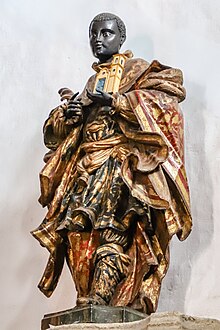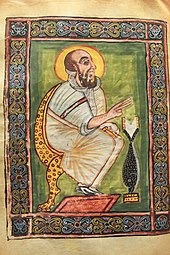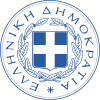Ethiopian Greeks
የኢትዮጵያ ግሪኮች Έλληνες της Αιθιοπίας | |
|---|---|
| Total population | |
| c. 500 | |
| Regions with significant populations | |
| Addis Ababa, Dire Dawa | |
| Languages | |
| Greek · Amharic · English | |
| Religion | |
| Greek Orthodox Church | |
| Related ethnic groups | |
| African Greeks · Egyptian Greeks, Sudanese Greeks |
Ethiopian Greeks, or Greeks in Ethiopia, are ethnic Greeks from Ethiopia. Today they number about 500 persons and can be traced back to ancient times. They are mainly located in the capital, Addis Ababa, and the city of Dire Dawa.
History
[edit]The name Ethiopia itself is Greek and means "of burned face".[1] It is first attested in the Homeric epics but it is unlikely to have referred to any particular nation, but rather, to people of African descent in general.[2][3]
Beginning in the Hellenistic age around the third century BC, Greek culture permeated the regions of ancient Ethiopia. Greeks established colonies in Ethiopia, with Ptolemais Theron and Axum becoming major capitals of Ethiopian Greek culture. In the second century BC, Ptolemy III Euergetes annexed several northern Ethiopian cities such as Tigray and the port of Adulis, which became major trading hubs for Ethiopian Greeks.[4][5]
Axumites of Ethiopia
[edit]

After the Romans annexed the Ptolemaic Empire, the Axumite king Zoskales (Ancient Greek: Ζωσκάλης) established the Axumite Empire (Ancient Greek: Ἀξωμίτης) (c. 100 AD–c. 960 AD), which maintained Ethiopian Greek culture and used Greek as its lingua franca. In the city of Axum, many obelisks, statues, and architecture made in Egyptian Greek style still mark the landscape.[4][6][7][8][9][10]
As the Islamic conquest of North Africa severed Axum's link with the Greek world in the seventh century, Greek culture and knowledge waned; Muslim presence in the Red Sea also caused Axum to suffer economically and it declined in power. Axum's final three centuries are considered a dark age, in which Ethiopian Greek culture disappeared; the Axumite Empire finally collapsed around 960 AD.[11] Despite its position as one of the foremost empires of late antiquity, Axum fell into obscurity as Ethiopia remained isolated throughout the Middle Ages.[12][13]
Abyssinian Greeks
[edit]
Later Abyssinian Greeks were attested in the 1700s, largely descending from Greek craftsmen and sailors residing in Abyssinia, who facilitated commerce between Abyssinia and Europe.[15][3] The explorer James Bruce reported that a number of Greek refugees from Smyrna had also arrived in Gondar during the reign of Emperor Iyasu II. The Smyrniot refugees included twelve silversmiths, whom the emperor put to work producing a variety of items for both his court and the churches of Gondar.[16]
Abyssinian Greeks held many of the highest positions in the Abyssinian Empire; the principal Abyssinian Greek community stayed with the Abyssinian Emperor in the capital, Gondar.[17] Emperor Theodore II specifically made known that he favored the Abyssinian Greeks, because of their virility and integrity of character.[18]
Modern Ethiopian Greeks
[edit]| Part of a series on |
| Greeks |
|---|
 |
|
History of Greece (Ancient · Byzantine · Ottoman) |
The Ethiopian Greek community saw its heyday in the early part of the 20th century with the establishment of the Holy Metropolis of Axum by the Patriarchate of Alexandria in 1908 and of the Greek organizations in Addis Ababa (1918) and Dire Dawa (1921).[19]
In 1969, an Association of Ethio Hellenic Studies was formed. The Founder President of the Association was Greek Metropolitan Methodios Fouyas of Aksum and the Vice presidents were Rev. Fr. Dr. V.C. Samuel, Dean of the Faculty of Theology and Dr. P. Petrides of the French Academy of Science. The Very Rev. L.S. Babte Mariam Workeneh was the Secretary General and Nicolas Geoprgkas, President of the Greek Community in Addis Ababa was the Treasurer. H.I.H. Merid Asfa Wossen Crown Prince of Ethiopia was the Patron and H.B. Archbishop Theophilos of Harar and Acting Patriarch of Ethiopia was the Chairman. To promote the scholarly works concerning Ethiopia and Greece and their historical and ecclesiastical heritage and achievements the Year Book ABBA SLAMA was published from 1970 to 1976.[20]
In the post-war period the community grew to 3,000 persons. It suffered during the revolution that overthrew Haile Selassie in 1974, when the hostility of the Derg towards all foreign communities drastically reduced its size to the current population of about 500.[19]
Today there is still a Greek school located in the capital as well as a Greek Orthodox church in the same city (St. Froumendios). The school has about 120 students, many of whom receive scholarships to continue their studies in Greece.[21] However there is an increasing initiative by Greeks to take advantage of the investment opportunities currently available in Ethiopia.[22]
See also
[edit]References
[edit]- ^ Liddell, Henry George; Scott, Robert, A Greek-English Lexicon (Online ed.), Tufts University, retrieved 2009-01-02
- ^ Natsoulas, Theodoros (1975), The Greeks in Ethiopia: Economic, Political and Social Life, c,1740-1936, Ph.D. dissertation, Syracuse University, OCLC 8152015
- ^ a b Dombrowski, Franz Amadeus (1985), Ethiopia's access to the sea, Leiden: E.J. Brill, p. 43, ISBN 90-04-07680-8
- ^ a b The Encyclopaedia Britannica: A-Androphagi. Cambridge University Press. 1910. p. 89.
- ^ "The" Journal of the Royal Geographical Society of London, Volume 17. Royal Geographical Society. 1847. p. 63.
- ^ George Hatke (2013). Aksum and Nubia: Warfare, Commerce, and Political Fictions in Ancient Northeast Africa. NYU Press. p. 26.
- ^ Africa and Its Exploration as Told by Its Explorers: Mungo Park, Clapperton, the Landers, Livingstone, Volume 1. S. Low, Marston, Limited. 1891. p. 98.
- ^ Louis François Jauffret (1852). Travels of Rolando, Or, A Tour Round the World. C.S. Francis & Company. p. 261.
- ^ English explorers (1875). The English explorers, comprising details of the more famous travels by Mandeville, Bruce, Park and Livingstone, with chapter on Arctic explorations. William P. Nimmo. p. 184.
- ^ William Henry Ferris (1913). The African Abroad: Or, His Evolution in Western Civilization, Tracing His Development Under Caucasian Milieu, Volume 1. Tuttle, Morehouse & Taylor Press. p. 494.
- ^ Derat, Marie-Laure (2020). "Before the Solomonids: Crisis, Renaissance and the Emergence of the Zagwe Dynasty (Seventh–Thirteenth Centuries)". In Kelly, Samantha (ed.). A Companion to Medieval Ethiopia and Eritrea. Leiden: Brill. p. 34. ISBN 978-90-04-41958-2.
- ^ Fritsch, Emmanuel; Kidane, Habtemichael (2020). "The Medieval Ethiopian Orthodox Church and Its Liturgy". In Kelly, Samantha (ed.). A Companion to Medieval Ethiopia and Eritrea. Leiden: Brill. p. 169. ISBN 978-90-04-41958-2.
- ^ Muḥammad Jamāl al-Dīn Mukhtār (1990). UNESCO General History of Africa, Vol. II, Abridged Edition: Ancient Africa. University of California Press. p. 234.
- ^ De Lorenzi, James (2015), Guardians of the Tradition: Historians and Historical Writing in Ethiopia and Eritrea, Rochester: University of Rochester Press, pp. 15–16, ISBN 978-1-58046-519-9.
- ^ Natsoulas, Theodoros (1975), The Greeks in Ethiopia: Economic, Political and Social Life, c,1740-1936, Ph.D. dissertation, Syracuse University, OCLC 8152015
- ^ Raymond Silverman and Neal Sobania, "Mining a Mother Lode: Early European Travel Literature and the History of Precious Metalworking in Highland Ethiopia", History in Africa, 31 (2004), p. 348
- ^ James Bruce (1812). Travels Between the Years 1765-1773 ... Into Abyssinia ... Comprehending an Interesting Narrative of the Author's Adventures in Abyssinia ... Being the Substance of the Original Work. [With Engravings, Including a Portrait.] J. & J. Cundee. pp. 46, 47.
- ^ Abba Salama Volumes 1-2. University of California. 1970. p. 54.
- ^ a b Bilateral Relations Between Greece And Ethiopia, Greece: Ministry of Foreign Affairs, archived from the original on 2006-07-15, retrieved 2009-01-02
- ^ ABBA SALAMA A review of the Association of Ethio Hellenic Studies Addis Ababa 1970.
- ^ Greeks in Ethiopia, AusGreekNet.com, retrieved 2009-01-02
- ^ "VI. The Greek Community", Hellenic & Ethiopian Bilateral Relations, Greece: Embassy of Ethiopia, archived from the original on 2011-07-21, retrieved 2009-01-02
Further reading
[edit]- Fouyas, P. G. (1971), "James Brice of Kinnaird and the Greeks in Ethiopia", Abba Salama (2): 161–178, OCLC 63208888
- Natsoulas, Theodore (1977), The Hellenic Presence in Ethiopia: A Study of a European Minority in Africa (1730-1946), Addis Ababa, OCLC 14575420
{{citation}}: CS1 maint: location missing publisher (link). Reviewed in Sbacchi, Alberto (1980), "Reviewed work ...", The International Journal of African Historical Studies, 13 (4), Boston University African Studies Center: 726–727, doi:10.2307/218207, JSTOR 218207 - Ghanotakis, Anestis John (1979), The Greeks of Ethiopia, 1889-1970, Ph.D. dissertation, Boston University, OCLC 9544485
- Fanouris, Mellina (2005), Meskel: An Ethiopian Family Saga, Tsehai Publishers, ISBN 0-9748198-9-1
